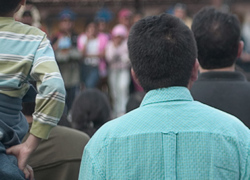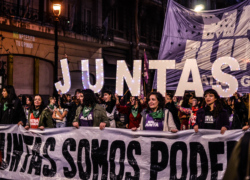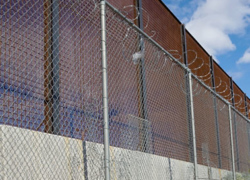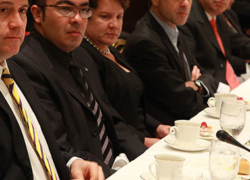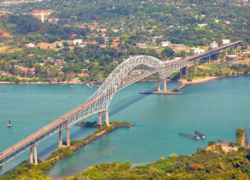Latin America Advisor
A Daily Publication of The Dialogue
Does Mexico Need Tougher Building Codes?
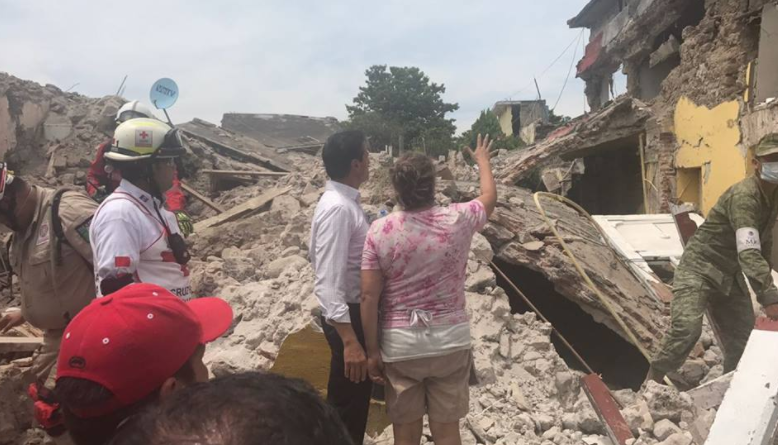 The Sept. 19 quake caused the collapse of several buildings in the central part of the country, where President Enrique Peña Nieto is pictured surveying damage on Sept. 20.
The Sept. 19 quake caused the collapse of several buildings in the central part of the country, where President Enrique Peña Nieto is pictured surveying damage on Sept. 20.
Hundreds of buildings in Mexico are reportedly at risk of collapsing or experiencing even greater damage following the powerful earthquakes that struck the country in September. Shortly after the Sept. 19 earthquake, the country’s education secretary declared only 676 of Mexico City’s 9,000 schools safe for reopening. Could more stringent building codes and construction designed to withstand earthquakes have prevented the building collapses seen last month, and should the government take steps to require such changes? How well has President Enrique Peña Nieto’s government responded thus far to the disaster? What are the country’s most pressing needs in the wake of the earthquake that rocked Mexico City and the one earlier in September that struck off the coast of Chiapas?
Héctor L. García Salgó, president for the Latin America region at Bechtel: "A comparison of the Sept. 19 earthquake and the 1985 earthquake, which struck Mexico City 32 years to the day earlier, shows that this year’s quake was less impactful to Mexico City in terms of loss of life and property. One reason may be that the city approved new construction codes in 1987 and 2004, including stringent seismic design requirements. More than 90 percent of the buildings that collapsed in September were built before 1985, while the few post-1985 buildings that did crumble may not have adhered to the construction codes. In the short term, those people who lost their homes, livelihoods and other productive assets continue to need humanitarian assistance. Concurrently, all structures should be inspected for integrity in the affected areas, particularly those known to be damaged, to determine if they are suitable for retrofitting or rebuilding to prevent future health and safety risks. As good practice, design and construction codes should be enforced through continuous independent supervision by certified professionals during construction. Over the long-term, federal and local governments may need to assist owners of damaged buildings in Mexico City, as well as in affected communities in the neighboring states of Morelos and Puebla, to build back better than before. While the human tragedy will never be forgotten, this is an opportunity for government, businesses, professional organizations and communities to work together, not only to improve construction methods and materials, but also to build greater resilience of communities to cope and recover faster from these natural hazards and save more lives in the future."
Amy Glover, CEO for Mexico at Speyside Corporate Relations: "The September earthquakes were both a tragedy and a moment of national reflection that will change Mexico’s future in important ways. The government’s deployment of the military and disaster relief was appropriate, and the acceptance of international assistance welcomed. The average citizen now feels more empowered than ever, after having taken a lead in facing the disaster. This new sense of solidarity has reminded Mexicans of why they love their country; it is not the flag or the anthem, but rather the community that matters most. While it is unclear how this will affect next year’s presidential election, candidates will certainly need to be sensitive to the fact that Mexicans do not feel helpless and are anxious to hear about concrete solutions that will solve the country’s challenges on issues like economic well-being, education, health and security. Building codes are technically up to snuff, but the enforcement of those codes needs to be ensured. This is just another example of the central national challenge: rule of law. Mexico needs a stronger and more efficient state to create the conditions for equitable economic growth, to allow the bonds of trust between citizens to grow, and to tackle corruption, which is simply a symptom of weak rule of law. Further, serious urban planning would certainly make Mexico City a safer place to live. While Sept. 19 will continue to weigh on the minds of Mexicans, the silver lining is the hope that arose from the rubble—the knowledge that life is precious, and that it is never too late to start moving in the right direction."
Andrés Rozental, member of the Advisor board, president of Rozental & Asociados in Mexico City and senior policy advisor at Chatham House: "If one compares the 1985 earthquake that caused heavy damage in Mexico City with the 7.1 seismic event that took place on Sept. 19, there are many quantitative and qualitative differences. Thirty-two years ago, we were basically unprepared for a disaster of such magnitude, and both government and the population suffered enormously. The numbers of dead and injured were in the many thousands, and the structures that collapsed or were irremediably damaged were extremely widespread and numerous. This time, although all human loss is unfortunate, fatalities from both earthquakes on Sept. 7 and Sept. 19 were in the low hundreds, not thousands. Material damage was widespread in Oaxaca and Chiapas, but in the country’s capital, the destruction was localized in certain parts of the metropolis. After 1985, building codes in Mexico City were changed to account for the eventuality of further tremors, and in fact, there have been numerous smaller and less destructive quakes that caused little or no damage since then. Now that we have multiple high rises in many parts of the city, these suffered little or no damage from the latest seismic event because they are built on earthquake-proof foundations. Most of the structures that collapsed or were seriously damaged this time were built before 1985 and therefore had little or no earthquake engineering technology. However, there is little doubt that building codes are not always enforced and corruption has a way of circumventing them. As with many of Mexico’s laws and regulations, the problem is with their application, not with the rules themselves. Mexico City will undoubtedly recover from this latest natural disaster, but the lesson to be learned is that strict enforcement of building codes needs to be strengthened and made mandatory, with heavy penalties for those who attempt to circumvent them."
Tapen Sinha, professor of risk management at the Instituto Tecnológico Autónomo de México and professor at the University of Nottingham Business School: "There are two questions about the building codes. First, had there been more stringent building codes, could the disaster have been less deadly? Most of the collapsed buildings were constructed before 1985 when new building codes were proposed. The only way it could have been less deadly is if these buildings were retrofitted or demolished. There were some efforts in retrofitting, but not comprehensive ones. Demolition was never politically feasible. We also have to keep in mind that Kobe, Japan had strict codes before 1995. Yet, collapsed buildings there killed nearly 5,000 people with a quake of magnitude similar to the Mexican one on Sept. 19. Second, can stringent building codes be properly implemented even if they are part of the plan? In Mexico, the answer is no. The collapsed school building shows that there were unauthorized constructions after what was authorized. This problem of informal construction is endemic in Mexico. Unless the corruption is rooted out in the building industry, this problem cannot be solved. The government responded better this time than it did in 1985. However, getting heavy machinery where it was needed to save lives did not arrive in time. The logistics of that process has to be improved. The so called ‘Guerrero Gap’ will cause another quake of magnitude 8 or higher within the next 30 to 50 years. Unless steps are taken now, it will be far more devastating than this one. The obvious need now is rapid reconstruction. However, much more needs to be done to retrofit the existing older buildings."
Juan Casillas and Pamela Starr, senior advisors at Monarch Global Strategies: "Following the devastating 1985 earthquake that rocked Mexico City, the government passed more stringent building codes that no doubt saved lives during the most recent earthquake to hit Mexico’s capital last month. The recent tremor was far less impactful than the 1985 quake in both loss of life and collapsed buildings. However, the impact could have been even less but for corruption and lax regulatory enforcement that is endemic to Mexico. Roughly 90 percent of the buildings that collapsed were constructed prior to 1985, but many of those would likely have held up had they been inspected properly and reinforced for compliance with the new codes. Further strengthening of building codes, such as enhancing minimum seismic design coefficient standards, and requiring owners to retrofit older buildings would help, but greater enforcement of existing law is a critical factor in mitigating damage from future quakes. Peña Nieto’s government has fared reasonably well during this crisis, to a great extent due to efforts over the years to emphasize preparedness and because the impact on physical infrastructure and human life was significantly less than in 1985. Going forward, it is imperative that the management of relief funds, whether governmental or not, be transparent, with disbursement devoid of any hint of political manipulation. Mexico’s civil society rallied strongly in the immediate aftermath of the earthquake in support of recovery efforts, and it should continue to play an important role during the rebuilding effort that will last for years."
The Latin America Advisor features Q&A from leaders in politics, economics, and finance every business day. It is available to members of the Dialogue's Corporate Program and others by subscription.




